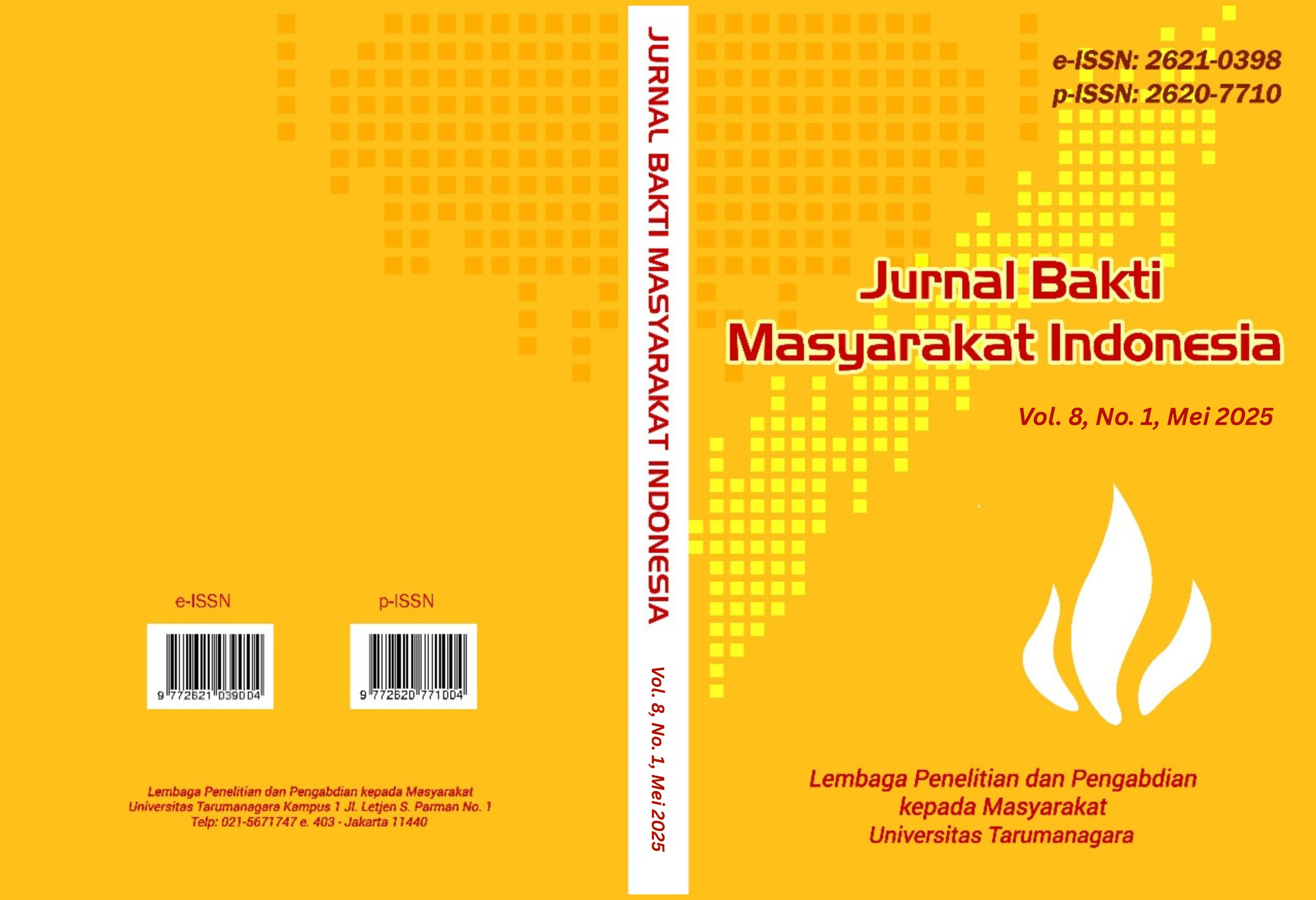PENDAMPINGAN PENGUATAN KOMPETENSI DIGITAL UNTUK MENINGKATKAN KESIAPAN KERJA DAN DAYA SAING REMAJA PUTUS SEKOLAH
Main Article Content
Abstract
This mentoring program aimed to empower school dropouts in Kwitang, Senen, Central Jakarta, by strengthening their digital competencies to meet the demands of the modern job market. Conducted over one month, the training combined online Zoom sessions and face-to-face consultations. It focused on three main areas: (1) using LinkedIn for personal branding and networking, (2) navigating job search platforms such as Jobstreet, Indeed, and Glassdoor, and (3) creating digital CVs using Canva. Evaluation included pre- and post-tests, mentor observations, and a satisfaction survey across five dimensions. Results showed that 87% of participants successfully optimized their LinkedIn profiles with a notable increase in connections, 80% produced industry-standard CVs, and 73% submitted at least three job applications within two weeks post-training. The average digital skills score improved from 45 to 82, and participant satisfaction scored 4.4 out of 5. These findings demonstrate the effectiveness of practical, mentor-guided training in enhancing job readiness among underserved youth. The hybrid learning model encouraged active engagement and provided flexible access to learning. Literature supports that digital literacy and personal branding positively influence employability. Despite challenges such as limited device access and varying motivation levels, the program offers a replicable model for similar communities. Future efforts should include digital certification and collaboration with industry partners to improve long-term impact. Overall, this program meaningfully contributes to reducing the digital skills gap and improving employment prospects for marginalized youth.
ABSTRAK
Kegiatan pendampingan ini bertujuan untuk memberdayakan remaja putus sekolah di wilayah Kwitang, Senen, Jakarta Pusat, melalui peningkatan kompetensi digital yang relevan dengan kebutuhan dunia kerja modern. Pelatihan dilaksanakan selama satu bulan dengan metode campuran daring dan tatap muka, mencakup tiga fokus utama: (1) penggunaan LinkedIn untuk membangun personal branding dan jaringan profesional, (2) pemanfaatan platform pencari kerja seperti Jobstreet, Indeed, dan Glassdoor, serta (3) pembuatan CV digital menggunakan aplikasi Canva. Evaluasi dilakukan secara kuantitatif melalui pra-pasca tes, observasi, dan survei berbasis lima dimensi. Hasil menunjukkan bahwa 87% peserta berhasil mengoptimalkan profil LinkedIn dengan peningkatan koneksi yang signifikan, 80% menghasilkan CV digital sesuai standar industri, dan 73% mengajukan lamaran kerja dalam dua minggu setelah pelatihan. Skor keterampilan digital rata-rata meningkat dari 45 (pra-tes) menjadi 82 (pasca-tes), dan survei kepuasan menunjukkan skor 4,4 dari 5. Temuan ini menunjukkan efektivitas pendekatan pelatihan berbasis praktik dan bimbingan langsung dalam meningkatkan kesiapan kerja remaja putus sekolah. Selain itu, integrasi metode daring dan onsite memungkinkan fleksibilitas dan keterlibatan aktif peserta. Studi literatur yang mendukung menunjukkan bahwa literasi digital, personal branding, dan kemampuan menggunakan platform digital memiliki korelasi positif terhadap peluang kerja. Meskipun beberapa tantangan muncul terkait akses perangkat dan variasi motivasi, program ini memberikan dasar yang kuat bagi pelatihan serupa di wilayah lain. Rekomendasi ke depan mencakup integrasi sertifikasi digital dan kemitraan industri untuk meningkatkan keberlanjutan dan efektivitas program. Secara keseluruhan, kegiatan ini memberikan kontribusi nyata dalam menjembatani kesenjangan keterampilan digital di kalangan remaja putus sekolah dan mendorong peningkatan kesejahteraan masyarakat.
Article Details

This work is licensed under a Creative Commons Attribution-NonCommercial-ShareAlike 4.0 International License.
This work is licensed under a Jurnal Bakti Masyarakat Indonesia https://creativecommons.org/licenses/by-nc-sa/4.0/
References
Badan Pusat Statistik. (2022). Tingkat pengangguran terbuka menurut provinsi 2022. Jakarta: Badan Pusat Statistik.
Bejaković, P., & Mrnjavac, Ž. (2020). The importance of digital literacy on the labour market. Employee Relations, 42(4), 921–932. https://doi.org/10.1108/ER-07-2019-0284
Brown, A. (2021). The impact of professionally designed CVs on job interview callbacks. Journal of Career Development, 48(3), 233–240. https://doi.org/10.1177/0894845319830529
CareerBuilder. (2019). How recruiters use online platforms to find talent. Retrieved from https://www.careerbuilder.com
Green, J., Martin, T., & White, K. (2019). The role of digital skills training in improving employability for disadvantaged groups. Digital Inclusion Journal, 15(2), 120–136.
Jobvite. (2018). The state of recruiting: Trends in job searching and hiring. Retrieved from https://www.jobvite.com
Khan, M. J., Bibi, Z., & Lalarukh, A. (2019). Digital skills gap and employability: Challenges and opportunities. Journal of Information Technology Education: Research, 18, 229–245. https://doi.org/10.28945/4360
Kee, Y. L., Teoh, H. Y., & Ahmad, S. Z. (2023). Digital competencies and perceived employability among youth: Evidence from Malaysia. Education and Information Technologies, 28, 4567–4584. https://doi.org/10.1007/s10639-023-11608-y
Michos, K., Cantieni, A., Schmid, R., Müller, L., & Petko, D. (2022). Examining the relationship between internship experiences, teaching enthusiasm, and teacher self-efficacy when using a mobile portfolio app. Teaching and Teacher Education, 109, 103570. https://doi.org/10.1016/j.tate.2021.103570
Nakibugwe, H., & Freeman, K. (2024). Digital skill proficiency and job placement among vocational youth in Uganda. International Journal of Training Research, 22(1), 19–35. https://doi.org/10.1080/14480220.2023.2271094
Reynolds, S. (2020). The importance of personal branding on LinkedIn for job seekers. Professional Networking Journal, 22(1), 35–50.
Smith, J. (2020). The rise of LinkedIn as a recruitment tool. Human Resources Journal, 18(4), 245–260.
Smith, J., & Johnson, K. (2019). Recruiter behavior: How long do recruiters spend on a CV? Journal of Human Resources, 40(3), 155–160.



